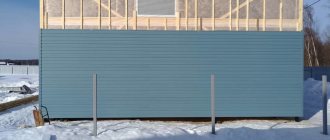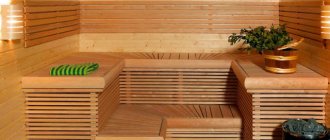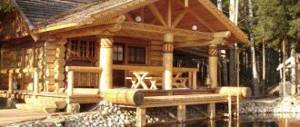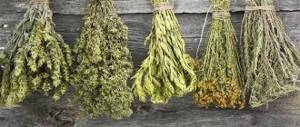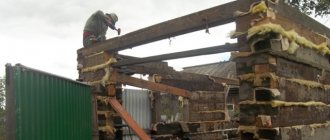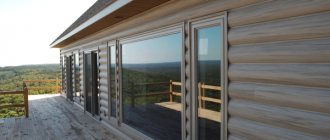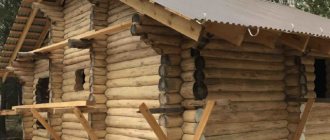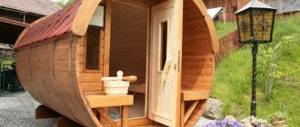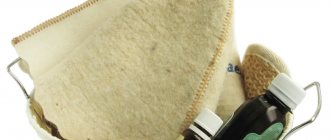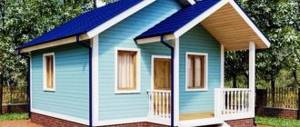Insulation of a foam block bath – Construction of saunas and baths
Insulation of a bathhouse made of foam blocks is an important stage of construction, on which the reliability of the structure and ease of use depend. The process of insulating such a bathhouse is quite simple and even a novice builder can do it.
Foam block walls do not require leveling after construction; their surface is almost perfect. Thanks to this, almost any finishing and insulation method can be applied to foam blocks.
Moreover, foam concrete blocks, due to their thickness and material characteristics, themselves are excellent thermal insulation. Therefore, insulating a bathhouse from such blocks will require minimal effort.
Finishing the walls inside a bathhouse made of foam blocks means protecting the foam blocks from regular exposure to moisture, in order to prevent deterioration of their characteristics, destruction and increase their service life. Before insulation, the walls must be treated with special impregnations with water-repellent properties, after which a special film insulation is made. But more about everything...
1. What needs to be done to insulate a bathhouse 2. Insulation for buildings made of foam concrete 3. Insulation of walls 4. Insulation of the ceiling 5. Insulation of the floor 6. Conclusion
What needs to be done to insulate a bathhouse
Let's consider thermal insulation options. This is done to ensure that the bathhouse is warm at any time of the year and that you feel comfortable and get maximum pleasure from taking bath procedures.
If, for some reason, the bathhouse cannot be insulated, then the heat will escape as quickly as possible. Accordingly, it will lead to financial losses, since the bathhouse will have to be repaired in the near future.
For a real bath, the temperature must be maintained.
Work on installing insulation for a bathhouse made of blocks is carried out in parallel with construction work . It all starts with insulating the foundation . It uses a material that is resistant to moisture, biological and temperature influences. The ideal option would be foam .
Installation of insulation is carried out after the concrete has hardened and the foundation formwork has been removed. The outside of the building is covered with a layer of waterproofing, after which it is covered with insulation sheets. The thickness of the insulation must be at least 5 centimeters. The best option would be to lay two layers of insulation 5 cm each in a checkerboard pattern.
After this, the surface of the foundation is plastered, preferably with “warm” plaster.
- The foundation in the bathhouse is insulated using mineral mats. A layer of expanded clay and slag is laid under the floor. To prevent the accumulation of moisture from inside the foundation, a ventilation hole is removed.
- Vapor barrier of walls . High-quality insulation of a bathhouse made of foam blocks is impossible without effective vapor barrier of the walls. The best material for this would be foil. It is laid on top of the insulation in vertical overlapping strips, without tension. Since foil is a rather thin material, it can be laid in two layers. The seams between the strips are sealed with reflective tape. The vapor barrier is installed in such a way that there is a small gap between it and the subsequent finishing of the bathhouse.
- A huge part of the heat escapes through window openings . Therefore, cracks that appear are sealed with any material that is less susceptible to burning. To eliminate fogging of glass, it is necessary to check how tightly the window frames fit to the frames. It will be very good if the windows have at least two glasses, and preferably three. But when insulating, it is worth noting that the shape of the windows must also be taken into account. The most optimal window shape is a rectangle that is elongated horizontally.
- To better retain heat, a small doorway . Doors and windows are required to be airtight.
- If in any place the thermal insulation is not done well or is simply not enough, this will have a significant impact on the heating of the bath.
Insulation for buildings made of foam concrete
It is usually recommended to use natural materials as insulation for bathhouse walls due to their environmental characteristics. For interior decoration, this requirement is justified. But synthetic insulation materials are also suitable for exterior decoration and insulation of baths. What materials are most often used for insulation?
Mineral wool is a popular material with good thermal insulation properties. It is resistant to high temperatures, withstands heating up to 1000 degrees, which allows it to be used not only for exterior, but also for interior decoration. Mineral wool is durable, resistant to biological influences, and is not susceptible to rotting or fungus formation.
Glass wool - has slightly lower thermal conductivity than mineral wool. For such a purpose as insulating a bathhouse made of blocks from the inside, it is not suitable due to its poor reaction to high temperatures. When worn out, glass wool emits an unpleasant odor, which also makes it unsuitable for interior decoration.
Jute felt is a natural insulation material of organic origin. Ideal for insulating bathhouse walls made of blocks inside and outside. It retains heat perfectly, is resistant to mold and mildew, has high strength and the ability to remove excess moisture from the room.
Expanded clay is a dry granular substance consisting of small balls of baked clay. Used for insulation of horizontal surfaces - floors, ceilings of bathhouses.
Polystyrene foam - usually used to insulate the outside of a bathhouse. They cover the facade with it, fixing it with glue or fasteners, and finish it with any chosen material - plaster, siding, panels.
Wall insulation
In order to insulate a bathhouse made of foam blocks, expanded clay or slag blocks, first of all, you need to choose insulation. Let’s say right away that the most environmentally friendly product in this situation will be felt, but since it is not available for sale on the construction market, we will have to choose from what is available. Foiled mineral wool
Based on the above data, we can come to the conclusion that in order to insulate a bathhouse made of expanded clay concrete blocks, of all the listed materials, mineral wool will be the most suitable (this includes stone wool, glass wool and slag wool). Its price is not very high, and you can choose the required thickness (from 20 to 200 mm) depending on the climate of your region. But in any case, you will need foil for waterproofing .
Foil polyethylene foam
If the mineral wool does not have a foil layer, then it needs to be added, and foil polyethylene foam, which you see in the photo above, is excellent for this. The thickness of such material varies from 2 to 20 mm, and by covering a layer of mineral wool with this, you significantly increase the effectiveness of thermal insulation.
U-shaped belt suspension brackets (pawns)
For wooden lining, that is, for cladding a steam room, you need a sheathing that will be attached to brackets, or it will be thick bars, between which insulation for the bath will be installed.
The second option is simpler, but installing timber on a block wall is not so easy, even if it is plastered.
The fact is that if the thickness of the sheathing is 100 mm, then anchor bolts will be needed to fasten it, which is not entirely acceptable for a wall made of such material.
Mineral wool is inserted through the consoles
We continue to consider how to insulate a cinder block bathhouse from the inside and will install the sheathing. Place some kind of waterproofing material on the wall, under the brackets, and then attach the consoles themselves with bod profiles. Mineral wool is threaded directly through the pawns, and then carefully covered with foil polyethylene foam, trying to ensure that no holes remain.
Advice! If you are interested in insulating plastic windows, then I can disappoint you - they are not insulated. Just so that they transmit less heat, you can use two-chamber or three-chamber double-glazed windows, as well as a thick, five-chamber plastic profile.
Ceiling insulation
Insulation of the ceiling in the bathhouse
The method of insulating the ceiling in a bathhouse made of foam blocks depends on the design of the roof.
If there is no plan to install a “working” attic , use an open type of ceiling insulation. In this case, the ceiling sheathing is covered with a layer of waterproofing, on top of which a layer of insulation is poured.
expanded clay is most often used for these purposes , covering it with a layer of at least 25 centimeters. But you can use the old-fashioned method - sprinkle the surface with sawdust and earth .
A layer of waterproofing is again laid on top of the insulation - roofing felt, polyethylene film, etc.
With a closed type of insulation, layers of insulation and waterproofing are covered on top with the attic floor. In this case, mineral wool is most often used as insulation. It provides the necessary thermal insulation with a thinner layer thickness than bulk insulation.
Installation of insulation occurs according to the same scheme as the insulation of bathhouse walls - vapor barrier, insulation, waterproofing layer. When thermally insulating and waterproofing a ceiling, only the installation plane changes.
Considering that there cannot be foam blocks on the ceiling, but, for example, a wooden floor or a concrete slab, timber can be successfully used as a sheathing.
Advice! To make it easier to install mineral wool on the ceiling so that it does not fall, use nylon thread. From beam to beam, a constriction is made in the form of a mesh, fixing the material.
Floor insulation
Bathroom floor insulation
The method of insulating a bathhouse floor depends on its design. If you are installing a “cold” leaky floor that has gaps between the boards to allow water to drain out, you will not be able to insulate it.
Insulation work can only be carried out with a “solid” non-leaking type floor. Such a floor is installed with a slight slope and equipment in the underground catchment area. To insulate a “deaf” floor, use mineral wool or expanded clay chips . The insulation is placed between the rough and finishing layers of the floor covering.
On the ground side, the insulation is protected with waterproofing; on the room side, a vapor barrier material is installed to protect the insulation from moisture. If a concrete floor is planned for the bathhouse, it is insulated by placing insulation in the screed. In the washing compartment you can install a “warm floor” system to provide additional comfort.
Conclusion
We looked at how to insulate a bathhouse made of foam blocks, and what material is most suitable for this.
Wood is an excellent insulation material, which means that the thickest wooden lining can be used (10-14 mm).
The use of wooden lining as a finishing material for a foam concrete bathhouse is a very popular solution, firstly due to the significantly lower price, and secondly due to its pleasant appearance and real aroma of wood, without which the bathhouse would not be the bathhouse that everyone knows.
It is advisable to make the floor in the bathhouse wooden or make a warm floor under the tiles on the floor. Sufficient care must be taken to seal all seams on doors and windows.
As you can see, building a bathhouse from foam blocks is not so difficult and you can probably do it. We hope that a bathhouse made of foam blocks will serve you for many years and delight you, giving you warmth and steam!
Source: https://www.proremont.ru/stroitelstvo-i-otdelka-bani/2613-uteplenie-bani-iz-penobloka
Insulation for foam blocks
In order to insulate a bathhouse, experts recommend using natural materials: this is true for internal insulation; for external insulation, you can give preference to synthetic insulation.
Bathhouse roof diagram.
- Mineral wool is a popular material that has good thermal insulation properties. It has sufficient resistance to high temperatures and can withstand heating up to 1000°C, which makes it possible to insulate the bathhouse both outside and inside. Mineral wool is resistant to biological influences, durable, and not susceptible to fungus formation and rotting.
- Glass wool has slightly lower thermal conductivity compared to mineral wool. This material is not used for embedded insulation due to its poor response to high temperatures. During operation, it wears out and emits an unpleasant odor, which also makes it unsuitable for interior decoration.
- Expanded clay is a dry bulk substance that consists of small balls of baked clay and can be used to insulate horizontal surfaces: the ceiling and floor of a bathhouse.
- Jute felt is a natural organic insulation material, ideal for insulating foam blocks inside and out. Its physical characteristics allow it to retain heat well, be resistant to mold and mildew, remove excess moisture and have high strength.
- Polystyrene foam is most often used for external insulation. They cover the facade with it, fixing it with fasteners or glue, and finish it with siding, plaster, and panels.
Let's talk about how to properly insulate a bathhouse made of foam blocks
The main purpose of any bathhouse is to create and maintain a constant high temperature inside it and (if it is a so-called Russian bathhouse and its analogues) the formation of water vapor in the air, which has a beneficial effect on human health, helps cleanse the body, remove toxins - and simply gives great pleasure .
If the bathhouse is built from foam blocks, then it must be insulated - this is the most important part of the measures for its proper functioning.
About foam blocks
Recently, foam block baths have become especially popular, because a foam block is a material obtained by foaming an aqueous concrete or cement mortar mixed with sand and a special protein substance. It is thanks to the protein that a foam solution is formed, when it hardens, a mass is formed with a uniform distribution of tiny air bubbles inside it.
A bathhouse made of foam blocks is much more accessible to the general population due to the low cost of the material. It is quite possible for even an inexperienced person to build it.
Foam blocks are light, durable, fireproof and moisture resistant, but still a bathhouse built from them must be insulated - even despite the high strength qualities of this material.
Materials for wall insulation
Let's take a closer look at insulating materials.
Minvata
Mineral (basalt) wool is very popular and is most often used for external and internal insulation of bathhouse walls. Excellent heat retention, very durable and noise-reducing properties. This absolutely non-flammable material can withstand heating up to 1000 degrees Celsius.
Mineral wool is harmless and biologically neutral, i.e. resistant to the formation of mold and fungi.
Glass wool
Glass wool is inferior to basalt wool in thermal conductivity. Internal insulation of bathhouse walls is impossible with it, because... glass wool cannot withstand heating above 400 degrees. In addition, when this material wears out, it begins to emit an unpleasant odor, which is completely unacceptable for a bathhouse.
Felt
Jute felt is of organic origin and is very good for insulating walls both inside and outside. It retains heat perfectly, is durable, resistant to mold, and has the ability to remove excess moisture from the room.
Expanded clay
Expanded clay is a dry heat-insulating substance consisting of light, tiny balls of baked fusible clay. Used for filling horizontal elements of a bath structure - for example, a ceiling or floor.
Styrofoam
Expanded polystyrene (foam plastic) - ideal for external insulation of bathhouse walls made of foam blocks. Typically, external walls are covered with polystyrene foam, fixed with glue and fasteners, and then plastered (or other decorative material is used).
Vapor barrier of bath walls
The most important nuance when insulating the walls of a bath structure made of foam blocks is the correct use of a vapor barrier layer indoors, especially in the steam room. Foiled polystyrene foam is used as a vapor barrier.
When laying heat-reflecting and vapor barrier layers between the interior wall finishing and the insulation, an air gap must be left. The internal finishing material is attached to a wooden sheathing - a special frame that is fixed on top of the heat reflector.
Vapor barrier polystyrene foam is applied to the wall in two layers, while its sheets are combined with each other end-to-end or overlapping, without tensioning the material. Additional sealing is provided using metal (mirror) tape.
A layer of mineral wool can be laid on top of the foil insulating layer on the internal walls of the bathhouse, which is separated from the internal decorative upholstery by a layer of waterproofing. The resulting air gap can be equipped with a ventilation pipe, which will prevent the accumulation of moisture in the thickness of the wall of the bath structure.
Completion of work
When building a bathhouse from foam blocks, it is extremely important to insulate the floor. Usually the foundation itself is laid with mineral fiber mats. An air gap is also created here between the blocks, from which a ventilation pipe comes out.
From the inside, the floor of the bath structure is insulated with mineral wool or expanded polystyrene and must be equipped with a heat reflector - foil film or polystyrene foam.
The gaps between the blocks are filled with expanded clay, which allows for even more insulation of the floor and at the same time has an air gap necessary for additional ventilation.
Insulation of the walls, ceiling, roof and floor of the bathhouse is carried out according to the general principles of thermal insulation. All seams, joints, and cracks in the insulating material must be sealed. Window openings and doors are small in size, and the windows are given a horizontally elongated shape. All this allows you to maintain as much as possible a constant high temperature and (if desired) humidity inside the bath.
Source: https://x-teplo.ru/uteplenie/bania/uteplenie-bani-iz-penoblokov.html
Differences in interior decoration
Cinder block baths and their interior decoration are characterized by high temperatures and high humidity, so a vapor barrier must be provided and installed on site. It is very often performed with the following materials:
- Foil (has 100% vapor barrier);
- Tiles and ceramics;
- Roll materials.
The first step is to cover the walls with paper without any impregnation. Next comes a layer of thermal insulation (mineral insulation can be used as it). The next layer is the vapor barrier itself, which is paper with a layer of foil, which does not allow moisture to penetrate into our insulation. Sheets of foil are connected to each other with special tape.
Because of all of the above, condensation will not form in our bathhouse, causing the foam blocks to deteriorate and lose their properties.
External insulation also helps get rid of condensation.
This occurs due to the fact that the temperature inside and outside the bath is equalized.
Next, we move on to the next stage, which is responsible for the aesthetics and attractiveness of the interior decoration of the aerated concrete bathhouse as a whole.
It is advisable to finish a bathhouse made of logs using wooden materials that are environmentally friendly and do not emit substances hazardous to human health when heated.
In this regard, the interior decoration of a bathhouse made of foam block and wood is not much different.
The most popular and economical finishing materials are cedar, larch and linden. The formation of condensation and loss of properties of a bathhouse made of logs, unlike a bathhouse made of foam blocks, is minimized.
Insulation of a bathhouse made of foam blocks: inside, outside, thermal insulation of walls
The advantages of foam blocks traditionally include lightness, fire safety, long service life and low cost. The successful combination of the characteristics described above turns it into one of the most common options when it comes to choosing materials for a bathhouse.
It is built in the shortest possible time and does not require significant financial investments. At the same time, the properties of the material and, first of all, its porous structure are vulnerable to cold and moisture.
In a bathhouse, given the specifics of the application, this requires additional insulation. The procedure is no different in complexity; you can order it from specialists or, after familiarizing yourself with the main points, perform it yourself. Careful work will be the key to a constant microclimate in the room, guaranteeing people warmth and comfort.
When starting the process of insulating a bathhouse, priority attention should be paid to the walls .
Here the main role is played by the internal frame, which ensures reliable fixation of the insulation and other materials used in the insulation procedure.
The insulation is evenly distributed under the frame, and then the structure is sheathed with waterproofing. Most often, it is based on foil and similar components, whose features prevent heat from escaping from the room.
As the name suggests, the material also serves as a reliable protection for walls and insulation from moisture. In no case should you neglect waterproofing, otherwise there is a high probability of mold, mildew and other unpleasant issues.
When the material is laid, the walls of the bathhouse are lined with wood. Here, ordinary lining or planed boards can be used with equal success. Along with interior decoration, external wall insulation is also used.
All features and stages of both procedures will be discussed below.
Important: wall insulation when building a bathhouse made of foam blocks may not be necessary, especially if the thickness of the blocks sufficient for your climate is used. It’s up to you to decide whether it’s worth insulating or not; further material will help you weigh the pros and cons.
Insulation materials
There is a huge amount of materials on the market for insulating foam block baths. Each of them has its own advantages and disadvantages, which this article will help you understand. So, most often used:
- Styrofoam . One of the traditional materials for insulation. Recently, it has been used less and less for walls, retaining heat worse than its competitors. At the same time, it seems to be the best option as insulation for the base and foundation;
- Glass wool . With proper waterproofing, it can reliably protect the room. Its structure includes glass production waste, sand, and felt. In general, it holds heat well, but the disadvantages include a specific smell during the aging process of the material;
- Expanded clay . It is used to insulate ceilings and floors by backfilling the corresponding areas;
- Jute felt . This is a completely natural material that is produced from the plant of the same name. In ancient times, felt was used in the production of burlap and other products, with excellent thermal insulation properties. The main advantage of the material is moisture rejection. As a result, along with insulation, it serves as additional protection against moisture. The disadvantages include fragility, as a result of which flax wool is on the market today, in which jute is combined with flax for greater strength;
- Basalt wool . Its main advantage is excellent fixation, which allows you to simply place the material under the frame without the use of dowels, etc. This is a mineral material, the result of processing certain rocks. In particular, as the name suggests, basalt wool is extracted from basalt. Today it has the highest thermal conductivity coefficient. Basalt wool is not subject to combustion, guaranteeing fire safety;
- Ecowool . An excellent choice for thermal insulation. It is a product whose structure consists of cellulose, antiseptics and fire retardants. When using it, you can do without vapor barrier, in addition, mice and rats do not eat the material. In Western Europe and North America, ecowool has been used for a long time; in Russia, its advantages are currently being actively studied;
- Waterproofing . Most often this is foil and materials made on its basis. Provide protection for materials and walls from moisture penetration, keeping them dry;
- Foiled polystyrene foam . Today, one of the most popular insulation methods is where polyethylene foam is covered with a protective layer of foil on top. It has the advantages of all the materials described above. It is durable, easy to install and long lasting. Among the disadvantages, the possibility of corrosion should be noted.
- Liquid insulation or polyurethane foam . It has been used relatively recently, having already noted excellent sealing properties, heat and sound insulation, absolute resistance to moisture, and an almost endless service life. It grips well on any surface and does not require the creation of a frame.
Insulation technology
Regardless of the type of material chosen as insulation, the following technology should be followed in the process. First of all, the floor is insulated, then the walls are equipped and at the final stage the ceiling is completed with materials.
The specifics of insulation presuppose the beginning of its use already at the construction stage, when builders use additional materials to protect the foundation and base.
Attention! It is important to use components that can easily withstand temperature changes, exposure to the environment, and are not subject to rotting and decay.
Insulation of a bathhouse made of foam blocks from the inside
In the video, pay attention to the explanation of why a bathhouse, unlike a residential building, is usually better insulated from the inside:
Internal insulation of walls made of foam blocks begins with filling the frame. Its function is perfectly performed by boards or slats with the indispensable condition of having enough indentation to accommodate the insulation. It is advisable to leave small holes in the upper part of the wall .
They are called vents , promoting additional ventilation. Windows are equipped with shutters or plugs are used to plug them during bathing procedures. The rest of the time it is recommended to keep them open.
As a result, moisture will not accumulate and the walls will remain dry.
After the frame is stuffed, the material chosen as insulation is attached to it. Depending on the choice and specifics, it can be fixed with nails, dowels, or simply inserted into the gaps. As already noted, it is desirable to use a component that has protective properties against rotting. Today, jute felt has the best performance on this point.
The most important step in insulating bath walls is vapor barrier . It must be used in two rooms, namely the washing room and the steam room. Without steam insulation, concrete and foam blocks will not be able to withstand increased exposure to moisture, not to mention maintaining the desired temperature, and will begin to deteriorate over time.
Along with the already mentioned foil and materials created on its basis, mirror film helps to isolate steam well. When laying the material, tension should be avoided by joining its elements to each other or by overlapping installation. Vapor barrier is relevant for the steam room and washing room; the dressing room and rest room can do without it.
After waterproofing the walls, they cover them with boards. This is the final stage of internal thermal insulation. It involves the use of antiseptics. Being applied to the boards they protect them from mold, mildew, bugs and other typical troubles.
External insulation
The outside of the baths is insulated using the ventilated façade technique with the necessary air gap. Foam plastic, jute felt and mineral wool have proven themselves well as materials here.
The main selection criterion here is cost.
In terms of its importance, external insulation in a bathhouse is significantly inferior to internal insulation , and it is left for later, and sometimes (if the climate and region allows) it is not used at all.
The floors and ceilings in the bathhouse are necessarily insulated, forming a single protective environment, without which the process cannot be considered complete.
Photo
So, if you master the technology, insulating a bathhouse from foam blocks is quite easy. The main factor here is the competent choice of material and its proper arrangement, and the emphasis is on internal work.
If you have time and desire, you can do the whole process yourself. If for one reason or another this is not possible, it is enough to contact a specialist.
In any case, the owner will have at his disposal a warm and comfortable bathhouse, always ready to welcome everyone into its arms.
See also : foundation and finishing of foam block baths.
Article in sections: How to build a bathhouse from foam blocks
Source: https://parilochka.com/vybor/penoblok/kak-stroit/uteplenie.html
Useful video about finishing
In order to understand how to properly and with what materials to decorate a bathhouse from blocks, watch this educational video.
Home page » What is the best material to build a bathhouse from? » Bathhouse made of foam blocks » How to build a bathhouse made of foam blocks » Practical interior and exterior decoration of a bathhouse made of foam blocks. How to finish it so that the eye is pleased?
Many of those who decide to get a bathhouse on a country site opt for foam blocks. This is a lightweight and cheap material that you can handle even without being a professional.
And yet, its features require careful attention to detail: if you do not want to freeze, it is better not to neglect the recommendation to use special glue instead of a cement mixture, and priming and waterproofing cannot be excluded from the list of finishing works, because this is fraught with destruction of the foam blocks.
The reasons for these requirements lie in the physical properties - the cement mixture has different thermal insulation indicators, and for glue they are close to foam concrete, water is easily absorbed by its porous structure, which is why walls made of this material need protection. By the way, in addition to waterproofing, thermal insulation will not hurt.
The last two points relate to finishing work. Let's take a closer look at how to decorate a bathhouse made of foam blocks inside and out. Let's start with the interior work. This article about foam block baths, their finishing, photos will help you too.
How to insulate a bathhouse made of foam blocks from the inside with your own hands?
A building made of foam blocks has many advantages: light weight and high thermal insulation properties. But a structure made of this material requires mandatory cladding, both external and internal. This is due not only to increased visual appeal, but also to the high porosity of the foam block.
That is why walls built from porous material need reliable waterproofing. This issue is especially acute when finishing the inside of a bathhouse. Today we’ll look at how to properly carry out waterproofing work and at the same time insulate a foam block bathhouse.
Used insulation materials
High temperature and humidity prevail in the bathhouse. Based on these operating conditions, thermal insulation materials are selected. The main requirements for bath insulation are heat and moisture resistance. When insulating a bathhouse from the inside, experienced craftsmen recommend using the following materials:
- Mineral wool has gained great popularity due to its properties. Resistance to high temperatures, mold and microorganisms makes its use quite justified. A significant advantage of this heat insulator is its affordable price.
- Jute felt is an organic insulation material. Its natural origin will greatly appeal to lovers of all things natural. Excellent thermal insulation properties and a fairly high price are the main characteristics of this material.
- Polystyrene foam and other foam insulation materials. They are light in weight and easy to install, and practically do not absorb water. The disadvantage is their instability to high temperatures, so it is not recommended to use polystyrene foam in the steam room.
Advice! In order to efficiently and reliably insulate the bathhouse floor, expanded clay backfill is most often used. This material is characterized by its availability, high mechanical strength and thermal insulation properties.
Bath insulation technology
To properly insulate a bathhouse made of foam blocks, it is necessary to cover all surfaces: floor, ceiling and walls with thermal insulation materials.
Floor insulation
You need to think about floor insulation even at the stage of building a bathhouse. To increase the protection of walls from groundwater, a layer of waterproofing should be laid between the foundation and the foam block masonry. Most often, ordinary roofing felt or similar materials are used for this.
Having erected the walls, you can proceed directly to the equipment and insulation of the floor. All work in this direction is as follows:
- The earthen base is leveled and covered with thick polyethylene in several layers. This is done to prevent moisture from seeping into the insulation layer.
- Then a layer of expanded clay, at least 10–15 cm, is poured in and compacted thoroughly.
- You need to make a cement screed on top of the expanded clay. In this case, you should use a reinforcing mesh, which can be placed directly on the expanded clay or buried in the thickness of the mortar during the process of pouring the floor.
- The top layer of the screed must be carefully leveled using a long rule.
After the cement screed has dried, the rough floor of the bathhouse is ready. Now it can be tiled with ceramic tiles or a wooden floor can be made.
Ceiling insulation
Without reliable thermal insulation of the ceiling, it is impossible to properly insulate the bathhouse from the inside. More than 90% of thermal energy rises to the ceiling and evaporates. There are two methods for insulating the ceiling:
- The first method requires the use of foil, which is placed on the ceiling of the bathhouse from the attic side. Then the foil is covered with a layer of waterproofing and the entire space between the rafters is filled with fine expanded clay. Then the expanded clay is covered with another layer of plastic film on top and the roof can be installed.
- The second method is more suitable for a bathhouse with an attic. In this case, instead of expanded clay, you can fill the ceiling with clay mixed with sawdust. The effective layer of such coating is 20–25 cm.
Wall insulation
In order to properly insulate the walls of a bathhouse from the inside, it is necessary to use frame technology:
- Wooden sheathing is mounted on foam block walls.
- A layer of waterproofing material is installed.
- Insulation is being installed.
- Then you need to install another layer of vapor barrier.
Advice! To increase thermal insulation properties, it is best to choose a vapor barrier material based on foil. This will shield thermal energy, thereby reducing heat loss.
Based on the above material, it is quite easy to insulate a bathhouse. A distinctive feature of such work for a structure made of foam blocks is the use of a large amount of waterproofing material. A properly insulated sauna will last a long time and bring a lot of positive emotions.
Source: https://utepleniem.ru/banya/kak-uteplit-banyu-iz-penoblokov.html
Subtleties of bath insulation
- External insulation and finishing of bath walls
- Insulation for foam blocks
- Insulation of the foundation and floor of a bathhouse made of foam blocks
- Vapor barrier of walls
- Ceiling insulation
Any structure made on the basis of foam blocks requires further internal and external insulation.
especially when it comes to a bath. This requirement is dictated not only by the desire to give an attractive appearance to the structure, but also by practical justification: insulating a bathhouse from foam blocks can significantly reduce the heat loss of the structure, increase ease of use and reliability of the structure. Diagram of a bathhouse made of foam blocks.
Thanks to the characteristics of the foam block, the insulation process is quite simple and can be carried out even by a novice builder, since preliminary work does not require leveling the walls.
Almost any method of insulation and finishing can be used on the surface of foam concrete.
The thickness and characteristics of foam concrete blocks allow them to be excellent thermal insulation.
How to insulate a foam block bathhouse from the inside – Construction and repair
A building made of foam blocks has many advantages: light weight and high thermal insulation properties.
But a structure made of this material requires mandatory cladding, both external and internal.
This is due not only to increased visual appeal, but also to the high porosity of the foam block.
That is why walls built from porous material need reliable waterproofing.
This issue is especially acute when finishing the inside of a bathhouse.
Today we’ll look at how to properly carry out waterproofing work and at the same time insulate a foam block bathhouse.
How to insulate the walls of a bathhouse made of foam blocks?
Previously, we already wrote about the construction of a bathhouse from foam blocks, where we examined several layout options and looked at how blocks are laid from this modern material, which has recently been gaining popularity in the construction of bathhouses. Foam blocks, unlike logs, beams or frame-panel structures, do not burn , do not support the spread of rot and mold, are not susceptible to woodworms and have high thermal characteristics.
In this publication, let's look at how to insulate walls made of foam concrete, what materials for insulation are best to choose, and how to make insulation in different rooms of a bathhouse.
Design features of bath walls
A special feature of the design of bath walls is the requirement for their thermal characteristics in combination with resistance to moisture, and in a steam room also resistance to elevated temperatures.
Moreover, unlike a country house, where at different times of the year a comfortable air temperature must be ensured with the least energy consumption, in a bathhouse the walls should retain heat only for the duration of its use, that is, periodically from time to time.
This allows you to reduce the amount of construction work by reducing the thickness of the wall and installing a stove of sufficient power that quickly warms up the room. It is believed that in a steam room the walls should be especially carefully waterproofed so that moisture from the room is not absorbed into the porous foam blocks.
This is partly true; the porous structure of foam blocks reduces their frost resistance, and if they get wet and subsequently freeze, such blocks can crack quite quickly.
At the same time, when visiting a bathhouse, the amount of water used in the steam room can be only 2-3 ladles of water, which, you see, is not the amount of moisture that can wet the walls enough to cause them to freeze.
A properly selected stove provides good draft, quickly “pumping” moist air outside the bathhouse.
And in order to expel humid air from the interior of the bathhouse to the street, after the bath procedures it is enough not to immediately put out the stove, but leave it to burn for another 15-20 minutes, throwing in 2-3 logs.
Insulation of a steam room made of foam blocks
You should take the most responsible approach to the choice of materials and insulation design in the steam room.
The insulation material should not emit toxic substances and withstand high temperatures well. Mineral wool can be an excellent choice.
Its advantages as insulation for a steam room include the following qualities:
- high value of heat transfer resistance;
- mineral wool does not burn;
- does not emit odor or harmful substances;
- does not support the spread of mold and mildew;
- not susceptible to being eaten by rodents and woodworms.
Mineral wool materials are perfect for insulating walls and ceilings in a steam room.
To lay heat-insulating material on the walls, wooden blocks with a thickness equal to the thickness of the insulation layer are hammered at intervals equal to its width.
Thermal insulation is rolled out between the bars, covered on top with a layer of vapor-waterproofing material (foil) and sewn up with clapboard.
To ensure air circulation between the insulation layer and the interior finishing, the lining is nailed onto an additional sheathing placed on top of the vapor barrier layer.
In general, the layers of the thermal insulation “pie” of foam block walls look like this:
External insulation and finishing of bath walls
You should take the most responsible approach to the choice of materials and insulation design in the steam room. The insulation material should not emit toxic substances and withstand high temperatures well.
Mineral wool can be an excellent choice.
Its advantages as insulation for a steam room include the following qualities:
- high value of heat transfer resistance;
- mineral wool does not burn;
- does not emit odor or harmful substances;
- does not support the spread of mold and mildew;
- not susceptible to being eaten by rodents and woodworms.
Mineral wool materials are perfect for insulating walls and ceilings in a steam room.
We invite you to familiarize yourself with: Do-it-yourself brick sauna stove: step-by-step steps
To lay heat-insulating material on the walls, wooden blocks with a thickness equal to the thickness of the insulation layer are hammered at intervals equal to its width.
Thermal insulation is rolled out between the bars, covered on top with a layer of vapor-waterproofing material (foil) and sewn up with clapboard.
On top of the insulation, the walls of the steam room can be finished with any environmentally friendly material that does not emit any harmful substances when heated and has good resistance to moisture and elevated temperatures.
The most popular finishing is made from hardwood lining - linden, cedar, larch.
You can also use tile finishing, which is laid on GVLV sheets (for example, Knauf supersheet with a straight (PC) or folded (FC) edge). To glue tiles in a steam room, it is recommended to use:
- Plitonite “super fireplace” is heat-resistant, reinforced, for tiling walls in the area where the stove is installed and the chimney is laid.
- Knauf tile standard for gluing tiles to the shelf level.
- Knauf reinforced fixation “elastic” (“Flex”) for all other areas.
Since foam blocks have high thermal characteristics, special efforts are usually not made to insulate walls made of this material. It is enough to insulate the walls from the inside using modern materials, as described above. Exterior finishing should be provided to protect foam blocks from moisture penetration. Finishing with siding, which has a beautiful appearance and a long service life, is well suited.
If there is a need to increase the thermal resistance of the walls, you can additionally arrange insulation using the type of ventilation facades. For this purpose, a frame made of metal profiles or timber of sufficient thickness is hammered onto the walls with the laying of rolled insulating material or heat-insulating mats with waterproofing that protects the insulation from the penetration of atmospheric moisture.
A sheathing is placed on top of the frame to provide an air gap, allowing air to move between the insulation layer and the siding. This promotes ventilation and prevents the formation of mold or rot. ***As you can see, the insulation of walls made of foam blocks is not much different from the thermal insulation of walls made of other materials.
Scheme of insulating a bathhouse from the inside.
Exterior finishing is used both as decoration and for protection from climatic influences. External thermal insulation of foam blocks can be made with almost any materials. The most popular is decorative plaster over insulation. It is characterized by high strength, durability and has good thermal insulation properties.
In order to give the surface of aerated concrete an attractive appearance, you can use cladding with artificial or natural stone. Thanks to this finishing, the structure will gain protection from external influences, but it will not provide thermal insulation properties.
Siding is one of the most popular finishing materials that can also be used to decorate a bathhouse. This popularity of the material is determined by its low cost and ease of installation. The air gap that forms between the siding and the wall of the bathhouse itself acts as an additional thermal insulation layer. However, experts advise laying a layer of insulation on the siding floor.
An equally promising option is the insulation of foam blocks with curtain facades made of composite panels. The advantage of this option is the ease of installation and the ability to carry out finishing work regardless of weather conditions.
Regardless of the material from which the bathhouse is assembled, the general vulnerability of the blocks is their high hygroscopicity. In severe frost conditions, moisture-impregnated raw materials are easily destroyed. In winter, after heating, the room cools down, no one monitors the temperature inside, and the frost resistance resource will quickly be exhausted.
Regardless of the specifics of the blocks, a single internal cladding technology is used.
This is the first stage of insulating the bathhouse. General sequence of work:
- The soil base is covered with glass wool, slag or expanded clay. To achieve an optimal level of heat retention, you should create a layer at least 35 cm thick.
- Next, the expanded clay concrete screed with reinforcement is assembled.
- A floorboard is sewn on top or ceramic tiles are mounted.
If you plan to install a concrete floor, the following guidelines for action are relevant:
- the rough concrete pad is equipped with coating or roll-type waterproofing;
- The next layer is to lay the insulation directly - mineral wool, polystyrene foam, expanded clay. The optimal thickness of the bookmark depends on the physical properties of the selected option;
- To create a ventilation gap, plastic screens are introduced and covered with reinforcing mesh on top. The latter should be hidden under a concrete screed.
The final stage here is the laying of ceramic tiles; if desired, you can finish the concrete base with wood material. This method of strengthening the foundation minimizes heat leakage.
For arranging wooden floors, experts recommend:
- create a subfloor by equipping the lower perimeter of the beams with cranial bars;
- fill the top with cheap wood adjusted to size;
- the subfloor must be equipped with vapor-tight waterproofing. The film should cover the entire area with an allowance of 20 cm on the walls. Fixation can be done using a construction stapler; to strengthen the joint area, you will need double-sided tape;
- You need to lay thermal insulation on top and cover it with film or roofing felt.
After filling the finished floor, the perimeter must be equipped with skirting boards. Wood needs additional protection in the form of moisture-repellent, antiseptic, and fire-retardant impregnations.
The porous structure of the building blocks helps reduce heat leakage, while the assembly of an auxiliary insulating pie will protect the structure from moisture accumulation in the smallest internal cells. In the case of cinder blocks, external insulation is not as important as internal insulation, so special attention should be paid to the design of the walls.
First of all, it is necessary to prepare the surface - clean it from dust and dirt, remove the remnants of any finishing, and plaster it so that a flat area is formed. Next, you can begin building up protective layers according to a specific algorithm:
- Assembling wooden sheathing. Here you can use budget timber, since it is undemanding in installation; it is only important that its thickness is at least 5 cm. The pitch (spacing) between the vertical lines of the frame should be 3-4 cm smaller than the dimensions of the insulating boards. In this case, it will be more convenient to place the insulating material in the cells.
- Basalt panels need to be placed in the resulting niches.
- It is necessary to create a vapor barrier layer on top. The best option is a foil membrane based on kraft paper. During installation, you need to ensure that the reflective layer is directed towards the inside of the room. The canvas is mounted with an overlap of at least 15-20 cm; the joint lines must be taped. The membrane is attached to the frame using a construction stapler.
We suggest you read: How to insulate a sauna in your home
To insulate the walls of a bathhouse made of blocks, you can use basalt panels
To maintain the required ventilation gap, you will need to sew a counter-lattice - it is created from beams that are mounted in the transverse direction. This measure facilitates the timely removal of condensate (moisture) from the foil side of the vapor barrier membrane.
At the final stage of work, all attention is paid to finishing the walls. It is recommended to line the steam room with natural wood with a low resin content. Panels or lining must be stuffed horizontally to make it easier to promptly replace the lower segments, which are inevitably destroyed due to frequent contact with water.
The kraft paper membrane can be replaced with foiled polypropylene - its characteristics help protect the “pie” from adverse factors.
Ceiling
The ceiling needs additional strengthening, as it is used in extreme conditions - with significant temperature changes, under the influence of hot steam. In this zone, experts offer two methods of work - open and closed. If the attic of the bathhouse is not equipped with a floor, the second method is relevant.
The ceiling is covered with a waterproofing membrane, and a layer of granulated expanded clay no less than 25 cm thick is poured on top. Next, waterproofing is laid again in the form of a plastic film or roofing felt, and a construction stapler is used to fix the coating.
The old method of strengthening the ceiling structure using an open method is also still practiced. Factory waterproofing film can be replaced with a homemade mixture of sawdust and fatty clay; the substance should be applied in a thick layer - from 4 cm. When the clay has dried, it can be covered with dry soil and oak leaves.
FINISHING foam blocks OUTSIDE
General principles of exterior cladding
What was said above about the aesthetic and technical purposes of interior decoration also applies to exterior decoration. When using a material such as foam blocks, there is a need for its hydro- and sometimes thermal insulation from the outside too.
There are practically no differences in installation: the same wooden frame, which is attached to the wall (again, let us remind you about specialized dowels for foam blocks and self-tapping screws) and serves as cells for filling them with heat insulator. A layer of waterproofing is applied on top and the last layer is decorative.
Today on sale you can find a material that successfully combines heat retention and moisture protection - this is foil foam, the basis of which is foamed polypropylene, covered with aluminum foil and coated levsan. However, you can give preference to mineral wool and conventional wind protection.
The differences begin with the choice of decorative finishes. The future owner of a bathhouse has enough options - this includes siding, and the same lining, made either of wood or plastic, imitation timber and a block house.
Siding finishing
This material consists of panels made of plastic, ceramic or metal with convenient fastening. The length upon purchase is from 2 to 6 meters, and the width is from 10 to 30 centimeters. On one side there is a perforated edge, which is convenient for driving nails into.
This material has two profiles: “herringbone” and “ship plank”, which means one or two fractures in the relief. The textures are different, often imitating natural materials.
Vinyl siding
Made from PVC. The material is not flammable, but melts in a fire. Does not require painting, protects the house from precipitation, is not afraid of large temperature differences, and is inert to many chemical influences. Plastic does not rot and is not of interest to rodents. It has many shades, of which the brightest ones are the most expensive - due to expensive additives that prevent fading.
It can be mounted both horizontally and vertically; the latter mount is called “soffit” and is used for lining roofs.
Metal siding
Stronger than the previous one and does not melt from fire. Made from aluminum or galvanized steel. Due to its low weight it can be used not only in low-rise construction. The fastenings are hidden, it looks seamless, which is good for facades. Dark-colored panels get very hot on a sunny day.
Ceramic siding
Made from fiber cement. Not afraid of fire, cold, or dirt . Externally it can imitate wood, stone and brick. Duration of service – up to 30 years. It does not fade in the sun, as they claim (although, frankly speaking, it is only a matter of time).
In addition, there is also a special type of siding used for cladding plinths. It is distinguished by increased strength and other improved characteristics, since the base heats up in the sun in the summer and gets wet under the sticking snow in the winter.
Whichever of the listed types is chosen, installation is carried out in the same way. An option could be a frame made of metal rather than wood.
Siding Alternatives
- imitation timber is a type of lining made of wood, but larger in width. It looks natural, like a bathhouse built from real timber, if you use coniferous lining 15 cm wide and 1 cm thick.
- block house is another type of imitation timber, only cylindrical. The great advantage of this natural material is that it is dried during manufacturing and is supplied with a humidity level of up to 12%.
- plastic lining is a cheap material with many disadvantages, which today is being successfully replaced by siding.
WALL INSULATION
Much has been said about wall insulation above - it is necessary if you do not want to spend a lot of fuel to maintain the required temperature in the bathhouse and if the thickness of the foam concrete blocks is not enough for your region. Often, when using blocks 20 or 30 centimeters thick, additional insulation is not necessary.
- The most environmentally friendly material for this purpose remains mineral wool, which has other advantages besides the fact that it does not emit harmful substances: it does not grow mold, it does not support combustion and retains heat perfectly.
- In addition to it, there is also cheap polystyrene foam or polystyrene. It is usually glued to the wall, then reinforced with mesh and plaster is placed on top. It can be used for baths, but its vapor permeability is lower than that of mineral wool.
- Bath walls can be insulated with basalt and stone insulation. They have excellent insulating properties, they are also environmentally friendly, non-flammable and (as a plus) mice do not like them.
- Glass wool can also insulate a bathhouse, but it cannot be used on the walls of a steam room - over time it will not withstand its temperatures.
As you can see, the choice of foam blocks as the basis for building a bathhouse has many consequences arising from the characteristics of this material, in particular, its readiness to absorb water. Compliance with the above rules will completely eliminate this drawback. Finishing a bathhouse from foam blocks makes this building material a very suitable option when it comes to choosing materials for building bathhouses.
